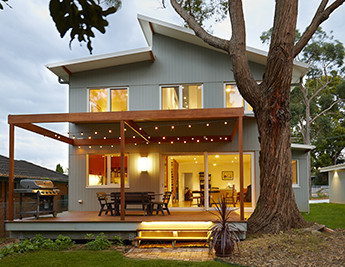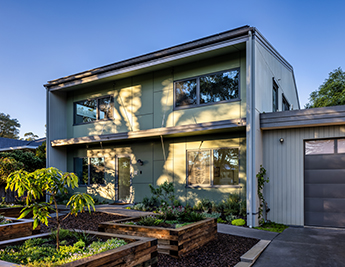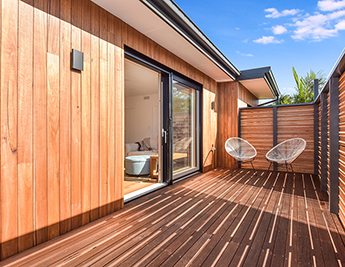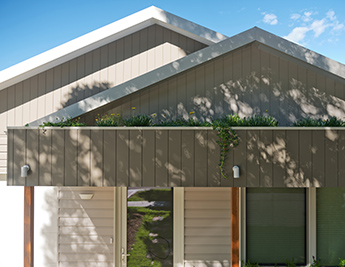BASIX and Passivhaus
How passivhaus just became cheaper in NSW
BASIX is world leading in its structure. It has been required in NSW since 2004, it requires all projects to meet requirements for energy, thermal comfort and water with the aim of encouraging sustainable residential development.
Until now, all projects seeking approval in New South Wales were required to either use NatHERS or the BASIX DIY tool to prove that their design (if built as designed) would achieve the thermal comfort requirements of BASIX; passivhaus is now also a compliance pathway.

BASIX now recognises the passivhaus standard as a pathway to meeting the thermal comfort requirements of the State Environmental Planning Policy.
The removal of this cost impost of passivhaus projects having to undertake modelling in multiple software packages is a win for designers and consumers.
Envirotecture (PhDC’s sister company), along with colleagues Detail Green were commissioned to provide the modelling to test the hypothesis that a certified passivhaus would achieve the aims of BASIX for thermal comfort.
The Short Version
Passivhaus designs were modelled in the NatHERS software, the results were compared against the BASIX caps; the minimum allowable performance in NSW.
On average the passivhaus single dwellings modelled outperformed the BASIX caps by 60% for heating and 51% for cooling. The worst performing for heating was a 26% improvement over the BASIX caps, the best performing was a 85% improvement. The worst performing for cooling was a 21% improvement over the BASIX caps, the best performing was a 67% improvement.
An apartment building was also modelled, it significantly outperformed the BASIX caps in all modelled climate zones. The heating performance improvements ranged from 39-95% over the BASIX caps. For cooling the range was 40-75%.
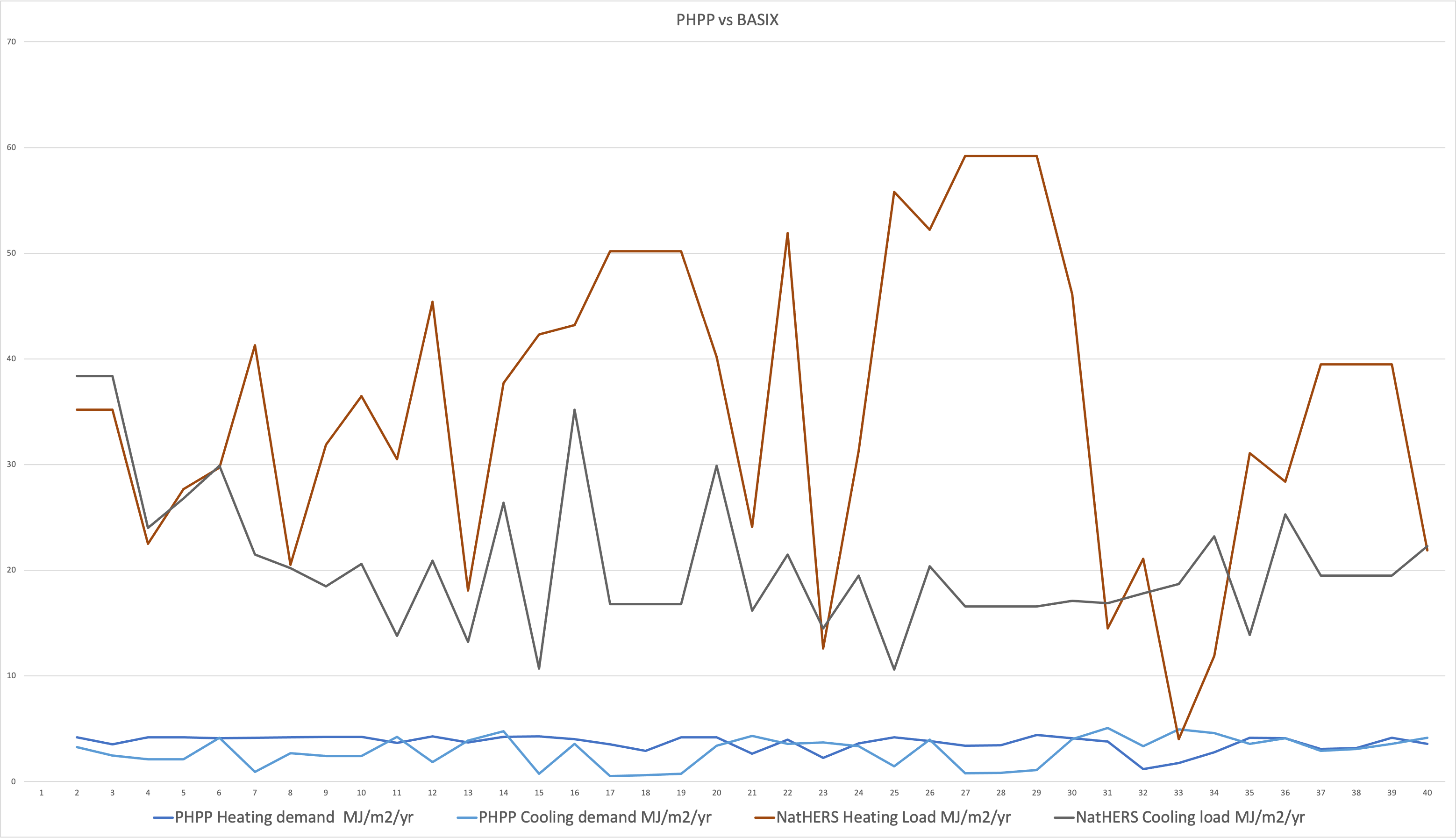
What does this mean for passivhaus projects
Now a single dwelling in NSW can use its passivhaus certification to prove compliance with BASIX. Your BASIX certificate will contain a number of requirements that ensure that the project is delivered as a certified passivhaus including meeting the 0.6ACH50 requirements for the air tightness test.
This process is perfectly aligned with those projects seeking passivhaus certification. As part of NSW Governments acceptance of this approach the passivhaus certification is required. It is acknowledged that it is a much higher bar than the current legal minimum (no proof of As Built quality at all!). We believe this is a great step forward, well aligned with the work of the NSW Building Commissioner in lifting construction quality and a reassuring tick for home owners too!
The Long Version
Five single dwellings and one apartment building (14 units) were used in the research. All dwellings were originally designed to meet the passivhaus standard.
Each building was simulated in NatHERS Climate Zone 28 (Richmond NSW). The original specifications (insulation, glazing, window frames, colours) of each project were adjusted so that each project only just meets the passivhaus standard for each of the climate zones it is modelled in.
Where the NatHERS climate zone encompasses more than one PH Climate Zone, the building was modelled with the same specifications required to meet the passivhaus standard in all of the PH Climates before being modelled in the single NatHERS zone.
No changes were made to fixed shading or building geometry. Each dwelling was modelled in the orientation that it was originally designed in.
Various construction types were modelled:
- suspended floor & timber framed walls,
- concrete slab on ground & brick veneer
- concrete slab on ground & timber framed walls
Various building types were tested:
| Description | Storeys | Beds | Floor area (m2) |
| Average detached house | 2 | 4 | 189 |
| Affordable detached house | 1 | 2 | 119 |
| Large detached house | 2 | 5 | 283 |
| Secondary dwelling | 1 | 2 | 60 |
| Attached house | 2 | 3 | 133 |
Only climates that have certified Passive House Institute climate data were used, they were:
| PHI-climate zone | NatHERS climate zone |
| Terrey Hills | 56 |
| Nowra | 18 |
| Sydney | 17 |
| Williamtown | 15 |
| Armidale | 14 |
| Albury | 20 |
| Katoomba | 24 |
| Moss Vale | 24 |
| Goulburn | 24 |
| West Wyalong | 48 |
A second round of modelled was undertaken to investigate the worse performing designs. These were all lightweight dwellings (no concrete slabs) as it was apparent that the NatHERS software was favouring thermal mass as a contributor to performance. This is no surprise in a dwelling that is assumed to be fairly leaky at ~10-12ACH50 (apparently somewhere near the dynamic assumptions in NatHERS).
Analysis
It is no surprise that passivhaus outperforms the bare legal minimum, it is often quoted as being 50-90% than Code compliance although this study appears to be one of the first attempts to quantify that in Australia. The average performance increase for single dwellings was 60% for heating and 51% for cooling, sitting well within that well-quoted range.
The climate in which the biggest difference was seen for heating was Sydney with the affordable detached house on a timber framed floor with an 85% improvement over BASIX caps.
The biggest difference for cooling was seen in Richmond with a 67% improvement over BASIX caps for the attached house with concrete slab on ground and timber framed walls.
Software differences
The inherent differences between the software packages are unable to be fully reconciled. It is worth noting that the following:
- NatHERS cannot model variance to air tightness, it has a fixed input
- NatHERS cannot model impacts of thermal bridging, both regular ( eg wall studs) or unique ( eg structure protruding through thermal envelope)
- NatHERS has allowances for air leakage from exhaust fans and downlights – these don’t exist in Passive Houses. So we haven’t modelled these in NatHERS for these buildings
- NatHERS models each room in the building and each is assigned a load profile for internal loads, PHPP assumes even IHG (internal heat gains) throughout
- NatHERS considers heat exchange between rooms within the building as some spaces are considered unconditioned, PHPP assumes the whole envelope is conditioned
- U values for windows modelled to AFRC in NatHERS, but to ISO10077.2 / EN 673 in PHPP, U values have been estimated for entry in NatHERS from PHPP data ( there is no easy conversion between AFRC and ISO10077.2 or EN673)
- NatHERS assigns a value for ventilated cavities in external walls with no restriction on how vented these cavities can be, PHPP has strict guidelines on how vented these cavities can be before they must be assumed to provide no R value at all and any structure external of these vented cavities must also be ignored in terms of R value
- Internal temperature setpoints differ between the two software packages. PHPP assumes building heated to 20 degrees and cooled to 25 degrees regardless of external climate. NatHERS assumes different set points for heating and cooling depending on the climate
- PHPP assumes building maintains allowable indoor temperature range 24-7, NatHERS assumes heating and cooling run for set hours and not overnight as per the HERS protocol
- PHPP is a static computer model, NatHERS is a simple dynamic model
- NatHERS uses ceiling fans as model inputs where present, PHPP assumes building is designed to maintain thermal comfort without needing ceiling fans
What this research does not show
The structure of the research is significant in that it did not attempt to answer the question, “how does NathERS compare to passivhaus”?
The aim was to assess whether passivhaus was an appropriate pathway for proving satisfaction of the thermal comfort within the parameters set by the NSW Government.
The research does not show that the passivhaus software (the Passive House Planning Package; PHPP) is better than the NatHERS system. However, it does show that passivhaus is a reliable approach to delivering buildings that outperform the current requirements in NSW (and nationally too).
Conclusions
It is a good day when it is made easier and more cost effective to deliver better outcomes for people!
 1300 348 006
1300 348 006
